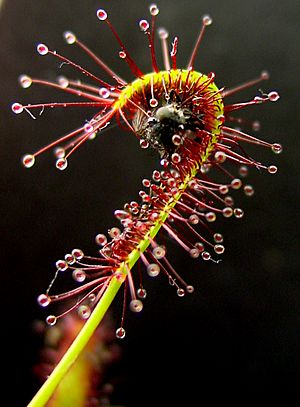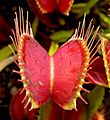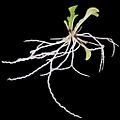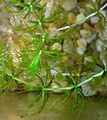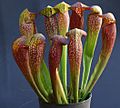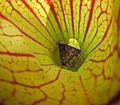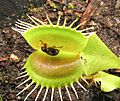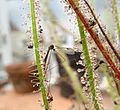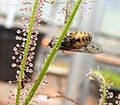Carnivorous plant facts for kids
Carnivorous plants are special plants that get some of their food by trapping and eating small animals, usually insects. Because they can get nutrients from animals, these plants can grow in places where the soil is very poor, like acidic bogs or rocky areas. The famous scientist Charles Darwin wrote an important book about carnivorous plants in 1875.
There are over 625 different kinds of true carnivorous plants. These plants attract, trap, and digest their prey, then use the nutrients from them. There are also more than 300 other species that are called protocarnivorous plants. They might trap prey but don't digest it in the same way, or they only show some of the traits of true carnivorous plants.
Contents
How Carnivorous Plants Trap Prey
Carnivorous plants have amazing leaves that act like traps. Scientists have found five main ways these plants catch their food:
Different Trap Types
- Pitfall traps: These are like deep cups or pitchers. The prey falls into a rolled leaf that holds a pool of digestive liquids or bacteria. An example is the pitcher plant.
- Flypaper traps: These plants have sticky leaves covered in a gooey substance called mucilage. When an insect lands on it, it gets stuck.
- Snap traps: These traps close very quickly, like a mouth. They use fast leaf movements to catch prey.
- Bladder traps: Found in Bladderworts, these traps suck in prey using a bladder that creates a powerful vacuum inside.
- Lobster-pot traps: These traps have inward-pointing hairs that guide prey deeper and deeper into a digestive area, making it hard for them to escape.
Active vs. Passive Traps
These traps can be either active or passive.
- Passive traps don't move to catch prey. For example, Triphyophyllum, a climbing plant from tropical forests, has long leaves that are sticky 'flypapers'. They just wait for insects to land.
- Active traps move to catch their prey. The Sundew Drosera is an active flypaper. All Sundew species can move their sticky tentacles. If an insect touches a tentacle, the others will slowly bend to bring the insect closer, helping the plant catch and digest it. Even a tiny gnat touching one tentacle can make this happen!
The Venus Flytrap: A Fast Mover
The Venus flytrap, Dionaea muscipula, is one of the few plants that can move very fast. When an insect or spider crawls on its leaves and touches a sensitive hair, the trap will only close if a different hair is touched within 20 seconds. This clever two-touch system stops the plant from wasting energy on things that aren't food, like raindrops.
How Carnivorous Plants Evolved
We don't have many fossils of carnivorous plants because they are usually soft herbs without wood. Scientists believe that true carnivory has developed on its own at least six different times in plant history.
Many scientists think that all types of traps might have come from a similar basic structure: a hairy leaf. Hairy leaves can catch and hold raindrops, which helps bacteria grow. Insects might land on the leaf, get stuck by the water's surface tension, and then suffocate. Bacteria would then start to decay the insect, releasing nutrients. The plant could then absorb these nutrients through its leaves. Plants that were better at holding water and insects would have had an advantage. Over time, leaves that cupped to hold more water could become pitfall traps, and leaves that became stickier could become flypaper traps.
Images for kids
-
An upper pitcher of Nepenthes lowii, a tropical pitcher plant that gets extra nutrients from tree shrew droppings.
-
Darlingtonia californica: notice the small entrance to the trap underneath the swollen "balloon" and the clear patches that confuse prey trapped inside.
-
The snap traps of Dionaea muscipula close rapidly when the sensitive hairs on the leaf lobes are triggered.
-
Stages and timing of the Venus flytrap carnivory process, Knowable Magazine.
-
Part-time carnivory in Triphyophyllum peltatum may be due to an unusually high need for potassium at a certain point in the life cycle, just before flowering.
-
Nepenthes mirabilis in a road cut in Palau. Showing habit and habitat.
-
Many Sarracenia hybrids are easy to grow.
-
Collembola (Dicyrtomina minuta) trapped inside a leaf of Sarracenia purpurea.
-
Glossy Black Idia (Idia lubricalis) moth trapped by Sarracenia purpurea.
-
Carabid beetle (Lebia grandis) trapped by Sarracenia purpurea.
-
Leaf beetle (Paria) trapped by Dionaea muscipula.
-
Red-eyed vinegar fly (Drosophila melanogaster) fly trapped by Drosera capensis.
See also
 In Spanish: Planta carnívora para niños
In Spanish: Planta carnívora para niños



